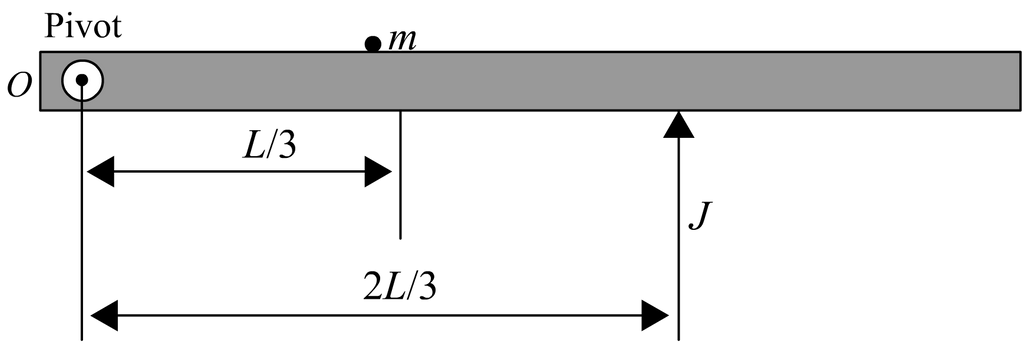Example
Collisions combined with pulley mass system

Example:
P and Q are two identical masses at rest suspended by an inextensible string passing over a smooth frictionless pulley. Mass P is given a downward push with a speed v as shown in figure. It collides elastically with the floor and rebounds immediately. What happens immediately after collision?
Solution:
Just after collision, P reverses its direction of motion causing the string to become loose. This results in zero tension in the wire. Q continues to move upward with velocity v due to inertia.
P and Q are two identical masses at rest suspended by an inextensible string passing over a smooth frictionless pulley. Mass P is given a downward push with a speed v as shown in figure. It collides elastically with the floor and rebounds immediately. What happens immediately after collision?
Solution:
Just after collision, P reverses its direction of motion causing the string to become loose. This results in zero tension in the wire. Q continues to move upward with velocity v due to inertia.
Example
Collisions with pulley mass system with tension as impulsive force

Example:
A block of mass and a pan of the same mass are connected by a pulley as shown in the figure. A particle of mass travelling with a velocity collides and stick to the pan as shown. Find the velocity of blocks after collision if initially the pan is at rest.
Solution:
Let be the contact force between the particle and the pan and be the final velocity. Impulse imparted equals the change in momentum.
For particle,
For pan,
For block,
Solving,
A block of mass and a pan of the same mass are connected by a pulley as shown in the figure. A particle of mass travelling with a velocity collides and stick to the pan as shown. Find the velocity of blocks after collision if initially the pan is at rest.
Solution:
Let be the contact force between the particle and the pan and be the final velocity. Impulse imparted equals the change in momentum.
For particle,
For pan,
For block,
Solving,
Example
Conservation of Angular Momentum for collision of rigid bodies

Example: A spherical ball of mass moving with initial velocity collides elastically with another ball of mass , which is fixed at one end of shaped rigid massless frame as shown in figure (a). The shaped frame contains another mass connected at the other end. What is the speed of the striking mass after collision?
Solution: Consider the L to be a single system. Its COM lies in midway of the diagonal.
The initial velocity of ball be and final velocity (in same direction) be .
Linear momentum is always conserved. Momentum imparted to the L-system after collision is =
About COM of L-system(just consider an axis about it) angular momentum of the 3 body system is conserved.
.
velocity of separation of the balls is
is horizontal component of velocity obtained by angular motion.
In elastic collision, velocity of approach = velocity of separation.
Therefore,
Solution: Consider the L to be a single system. Its COM lies in midway of the diagonal.
The initial velocity of ball be and final velocity (in same direction) be .
Linear momentum is always conserved. Momentum imparted to the L-system after collision is =
About COM of L-system(just consider an axis about it) angular momentum of the 3 body system is conserved.
.
velocity of separation of the balls is
is horizontal component of velocity obtained by angular motion.
In elastic collision, velocity of approach = velocity of separation.
Therefore,
Example
Coefficient of restitution in collisions involving rigid bodies
Example: A uniform vertical rod of mass and length is hinged at its highest point and is initially at rest. A small pendulum of mass m and string length , is also suspended from the same point. Initially it is at an angle 60 with vertical and then it is released. The pendulum strikes the rod, just after collision, the pendulum comes to rest, the angular speed of the rod becomes and coefficient of restitution of this collision is , then, find and angular velocity.
Solution: The ball will strike the rod with a velocity of
Applying angular momentum conservation about the hinge point
get
also
where
So
Solution: The ball will strike the rod with a velocity of
Applying angular momentum conservation about the hinge point
get
also
where
So
Example
Problems on inelastic collision of point masses with rigid bodies rotating about fixed axis

Example: A uniform rod of length L and mass M is lying on a frictionless horizontal plane and is pivoted at one of its ends as shown in Fig. There is no friction at the pivot. An inelastic ball of mass m is fixed with the rod at a distance L/3 from O. A horizontal impulse J is given to the rod at a distance 2L/3 from O in a direction perpendicular to the rod. Assume that the ball remains in contact with the rod after the collision and impulse J acts for a small time interval . Find the resulting instantaneous angular velocity of the rod after the impulse.
Solution:
Let the system starts with angular velocity . Angular velocity
of the ball will also be as it remains struck to the rod.
Velocity of the ball
For the rod, angular impulse change in angular momentum:
....(i)
For the ball, impulse change in linear momentum
....(ii)
From Eqs. (i) and (ii), and
Let impulse on the pivot be
For the rod and ball system, total impulse change in linear momentum:
Solve to get:
Solution:
Let the system starts with angular velocity . Angular velocity
of the ball will also be as it remains struck to the rod.
Velocity of the ball
For the rod, angular impulse change in angular momentum:
....(i)
For the ball, impulse change in linear momentum
....(ii)
From Eqs. (i) and (ii), and
Let impulse on the pivot be
For the rod and ball system, total impulse change in linear momentum:
Solve to get:
Example
Elastic collision of point masses with rigid bodies rotating about fixed axis

Example: An impulse at one end of a stationary uniform frictionless rod
of mass and length which is free to rotate in a gravity-free
space. The impact is elastic. Instantaneous axis of rotation of the rod
will pass through which place?
Solution:
Velocity of the CM of rod
Applying impulse momentum equation about the CM of rod
About instantaneous axis of rotation the rod is considered to have pure rotation.
Let instantaneous axis of rotation be located at a distance from the colliding end [Fig (b)]
....(i)
Substituting the value of in Eq. (i), we get .
of mass and length which is free to rotate in a gravity-free
space. The impact is elastic. Instantaneous axis of rotation of the rod
will pass through which place?
Solution:
Velocity of the CM of rod
Applying impulse momentum equation about the CM of rod
About instantaneous axis of rotation the rod is considered to have pure rotation.
Let instantaneous axis of rotation be located at a distance from the colliding end [Fig (b)]
....(i)
Substituting the value of in Eq. (i), we get .
Example
HInge force on rigid bodies
Example: A thin uniform square plate with side and mass can rotate freely about a stationary vertical axis coinciding with one of its sides. A small ball of mass flying with velocity at right angles to the plate strikes elastically the centre of it. Find the horizontal component of the resultant force which the axis will exert on the plate after the impact.
Solution: Angular momentum conservation:
From above solution,
Substituting in momentum equation, we get,
Horizontal reaction force acting on the plate will be the centripetal force given by,
Solution: Angular momentum conservation:
From above solution,
Substituting in momentum equation, we get,
Horizontal reaction force acting on the plate will be the centripetal force given by,
| BookMarks |
0 Comments
Post a Comment